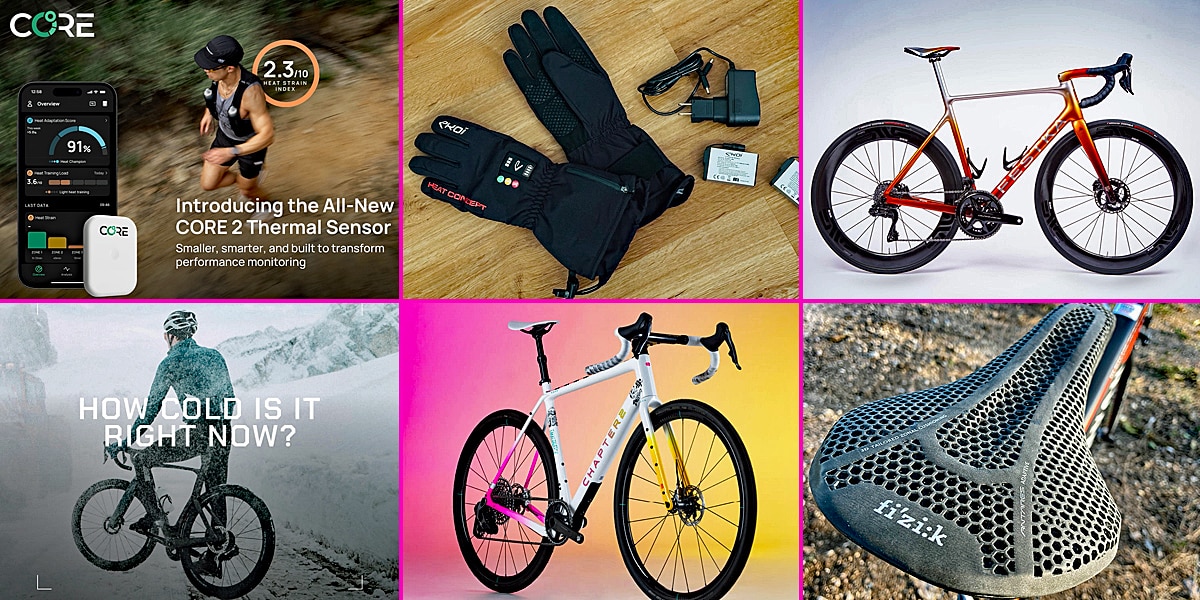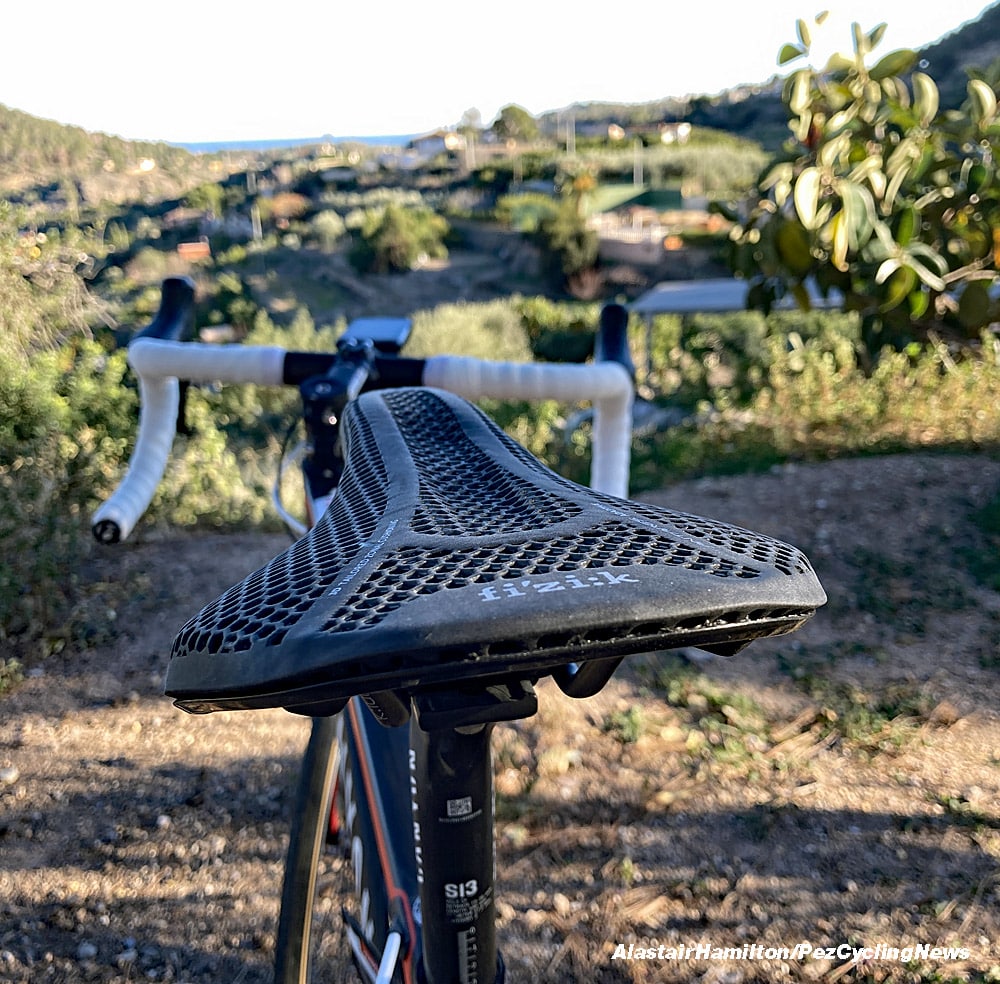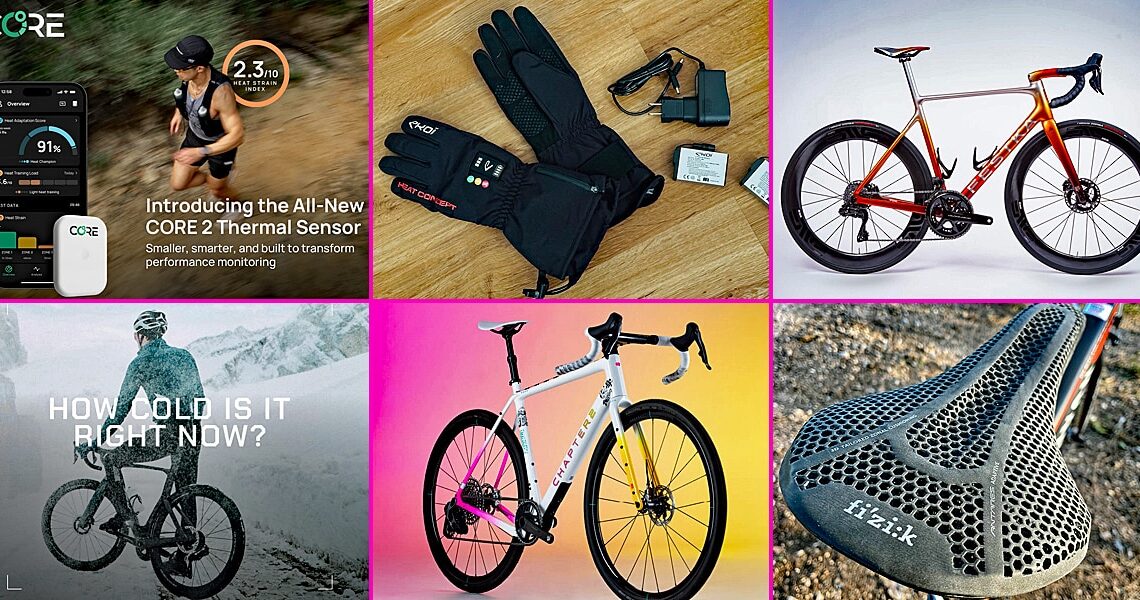
Gear Break: fizik Vento Antares R3 Adaptive 3D-printed saddle, Ekoï Perf HEAT CONCEPT 5 heated gloves, CHAPTER2 Bikes: Lets get weird on KAHA TJ, CORE 2 unveiled: Smaller, smarter, and built to transform performance monitoring, Q36.5: How cold is it right now? And the most popular FESTKA bikes in 2024 on social media.
fizik Vento Antares R3 Adaptive 3D-Printed Saddle
A versatile saddle designed with a low-profile, tapered nose-to-wing transition, and Adaptive 3D-printed padding to provide comfort in every riding position.

Alastair Hamilton PEZ sez: Fifty years ago I had a Brooks leather saddle on a borrowed Carlton race bike, from there I went on to a Cinelli Unicanitor saddle, which had a little bit of padding. Saddles have changed a lot since then and now we have 3D-printed saddles. What next?

I’ve mostly been riding Selle Italia saddles and apart for trying a fizik Aliante about 20 years ago, I’ve stuck to what I know suits me. The thought of using something different was a bit daunting. Measuring the Antares, the dimensions are very similar to the Selle Italia SLR, slightly longer and about the same length as the Flite. So maybe nothing to worry about… Let’s find out. I had to make one adjustment, I had set the distance from the nose of the saddle to the centre of the handle bars, the same as the SLR, but it felt too far back. I moved it forward by about a centimetre, which felt just right. When remeasuring, the distance from the back of the fizik Antares to the centre of the bars was the same as the measurement from the back of the SLR.

The Zwift saddle test
All the technical details you can read bellow, what you want to know from me, ‘was it comfortable?’ The first two rides were on Zwift (other platforms are available), as this must be the best test for a saddle. You spend most of the time sat down and you do put a lot of pressure on ‘that part’ of your body when home training. Plus you can concentrate on the feeling without any road distractions. Yes, it is comfortable and the extra length allows you to move around a bit more, which is nice. I found I was more on the sit bones than on other saddles, and felt like I was pushing back against something. There was no pressure on the ‘family jewels’ and there was no rubbing, chaffing or pressure in the centre part of the saddle. So all good.

Obviously the 3D-printed padding is the big difference for other saddles. The centre section is fairly soft to protect the prostate area, as are the ‘wings’, the widest part of the saddle, which gives comfort to the back of the thigh at the bottom of the down-stroke. The hardest part of the saddle is at the sit bone area, with a medium hardness either side of the soft centre and at the nose. The shell is solid with a bit of ‘give’ in the centre, the lightweight rails are joined perfectly to the base, all very well manufactured. I weighed it in at 226g, but my scales are usually around 5g heavy, so fizik’s 220g is probably about right.

220g would be about right
Out on the road, in the real world, the saddle performed just as well. I’ve only managed to get out for just under two hours and there was no discomfort and all felt good. No complaints. This not the first 3D-printed saddle I’ve ridden and the technology is probably going to work its way down the price range and we will see 3D saddles at the lower level, eventually. It does feel different, comfortable yes, but the surface of the saddle isn’t smooth. This didn’t bother me and with good quality shorts you might not even notice, you maybe don’t move around as much which suits some people, but maybe not everyone. On the whole, the fizik Vento Antares R3 Adaptive 3D-printed saddle is a top of the range saddle with the comfort and padding in all the right places. It’s what you want/need from a saddle.

What fizik say: A high-performance saddle with a streamlined shape and tapered nose-to-wing transition, now available with Adaptive padding, our most advanced 3D-printed padding technology.

The Future of Performance
Part of a new generation of Antares saddles, the Antares R3 Adaptive maintains many iconic design features that have long made the original so popular amongst leading athletes. First introduced over twenty years ago, Antares has appeared in nearly every Grand Tour since. Reimagined in our innovative Adaptive padding, Antares is ready to make history again. Delivering performance and comfort, from road to CX and XC, the Antares R3 balances strength and weight savings with a carbon-reinforced nylon shell and Kium hollow rail combo.

3D-Printed Padding
Fizik Adaptive 3D-printed padding has expanded to the Antares family, creating the perfect match for those who want exceptional, long-lasting comfort on a low-profile performance saddle designed to allow a more connected feeling for optimal pedalling efficiency and power transfer.

Tailored Zonal Cushioning
The evolution of digital 3D printing has allowed us to develop a new saddle without the constraints or limitations imposed by traditional production methods and materials. The Adaptive saddle padding is crafted by Carbon® using their revolutionary Digital Light Synthesis technology. DLS is an additive manufacturing process which uses digital ultraviolet light projection, oxygen permeable optics, and programmable liquid resins to produce parts with excellent mechanical properties, resolution, and surface finish.
technology. DLS is an additive manufacturing process which uses digital ultraviolet light projection, oxygen permeable optics, and programmable liquid resins to produce parts with excellent mechanical properties, resolution, and surface finish.

Lab Tested, Road Proven
Using Carbon® technology, biomechanics and engineers have an unprecedented possibility: to design and manufacture multiple functional zones within the saddle, tuning each of them separately for specific mechanical properties. Each of these key functional zones is engineered for a distinctive cushioning and mechanical response, joined together progressively and seamlessly in the same padding. The result? A 60% reduction in peak pressure through improved weight distribution for increased comfort across the entire saddle surface.

Power Transfer & Pressure Relief
Antares is a low-profile saddle with a tapered transition from nose to wing that helps riders deliver efficient pedalling in every riding position. 3D-printed padding provides a responsive, race-ready feeling to better connect rider and bike. Through this technology, we are able to incorporate a softer central zone instead of a traditional cut-out to provide better pressure relief without sacrificing performance. No matter if you’re attacking a climb or holding the tempo on flat terrain, Antares R3 Adaptive is designed to support you.

Check the fizik website for your area for price.
Technologies/Specifications
- ADAPTIVE: Carbon® Digital Light Synthesis
 3D-printing technology, offering seamlessly engineered zonal cushioning
3D-printing technology, offering seamlessly engineered zonal cushioning - ANTARES: Low-profile performance saddle designed to allow a more connected feeling for optimal pedalling efficiency and power transfer
- R3: Combination of a ride-compliant, carbon-reinforced nylon shell and a Kium hollow rail with a high strength-to-weight ratio
Antares Adaptive R3 140mm
- Length: 268mm
- Width: 140mm
- Height at 75mm width: 50mm
- Length from nose to 75mm width: 147mm
- Weight: 220g
- Rail: 7x7mm
Antares Adaptive R3 150mm
- Length: 268mm
- Width: 150mm
- Height at 75mm width: 50mm
- Length from nose to 75mm width: 147mm
- Weight: 225g
- Rail: 7x7mm
- More info at: www.fizik.com .
Ekoï Heated Gloves Perf HEAT CONCEPT 5 – $279.99
NOTE: Pricing is MSRP and may not reflect any discounts being offered

These heated gloves, effective down to -10°C, provide even warmth thanks to the heat concept system with its three adjustable levels. Breathable and moisture-resistant, they offer warmth, joint flexibility, and safety with non-slip palms.
Palm
- Synthetic coating: easy maintenance / durability / flexibility
- Non-slip silicone inserts for a perfect grip on the [handlebar] in dry or wet conditions
Back of the glove
- Warm and breathable membrane
- High cuffs for optimal protection
- Elasticated at the wrists to prevent air entry
- Velcro closure
- Elastic strap closure for a better glove fit
- Palm with non-slip silicone inserts
2-year warranty on gloves and batteries

Silicone on the thumb and palm for grip
Chuck Peña PEZ sez: The first thing you notice about the Ekoï HEAT CONCEPT 5 gloves (I’m going with this nomenclature for the sake of brevity) is that they’re definitely bigger than normal full-finger cycling gloves. At first glance, you might mistake them for ski gloves — Ekoï rates them as “moisture-resistant” (but not waterproof) so maybe they’d be OK in the snow.
 There’s no mistaking the Ekoï HEAT CONCEPT 5 (left) for regular riding gloves (right)
There’s no mistaking the Ekoï HEAT CONCEPT 5 (left) for regular riding gloves (right)
Some of that is due to a little more bulk courtesy of Thinsulate insulation. But most of it is because of the elongated cuff, which is for the battery. And that’s what makes the Ekoï HEAT CONCEPT 5 gloves decidedly different than typical winter/cold weather riding gloves.
 Charge up the batteries (NOTE: I had to have Ekoï send an appropriate plug adaptor for US outlets)
Charge up the batteries (NOTE: I had to have Ekoï send an appropriate plug adaptor for US outlets)

Connect and insert the battery into the compartment in the cuff

Green arrow – Long press to turn on/off and short press to toggle between temperature. levels Blue arrow – Temperature level indicator. Yellow arrow – Battery charge level.

Temperature/heat levels left to right: Low (green) max 4 hours, medium (orange) max 3 hours, high (red) max 2 hours (NOTE: 4 bars means the battery is fully charged)
I haven’t ridden in the Ekoï HEAT CONCEPT 5 gloves, but I’ve tested them out by just wearing them outside when the temp has been below freezing and I could definitely feel the warmth. And that’s what makes the Ekoï HEAT CONCEPT 5 gloves different. Regular winter gloves provide insulation to help you retain body heat (so really to help keep you from getting too cold). The Ekoï HEAT CONCEPT 5 gloves provide actual heat to warm your hands up. For me, in below freezing and on the high setting it was comfortably toasty.

I’ll be honest, the Ekoï HEAT CONCEPT 5 gloves are overkill for my winter riding down in the Lowcountry because: (1) average winter temperatures are lows in the 40s and highs in the 50s and (2) even if temps do dip into the 30s (they have and we’ve even had a few mornings with the temp in the 20s!), I’m no longer an HTFU or #9 kind of rider (I’m not afraid to be called a wimp in my AARP years) and willing to layer up and brave the cold (this is why god invented Zwift and why I have a Wahoo KICKR BIKE). So even though I have the kit to be able to ride when it gets down to (and even below) freezing, I just don’t have the fortitude to brave the cold.
But if you are a better man (or woman) than me and are riding through the winter in true winter conditions, the Ekoï HEAT CONCEPT 5 gloves are definitely worth serious consideration.

Don’t want your hands/fingers to freeze? The Ekoï HEAT CONCEPT 5 gloves may be just the ‘droids you’re looking for.
CHAPTER2 Bikes: Lets Get Weird on KAHA TJ
CORE 2 Unveiled: Smaller, Smarter, and Built to Transform Performance Monitoring
CORE, the folks behind the trusted body temperature sensor for top cyclists, triathletes, runners, and endurance athletes, are raising the bar again with the new CORE 2 sensor. Smaller, lighter, and smarter, this next-generation sensor delivers cutting-edge features to help athletes master thermal load management during training and competition.
The go-to body temperature sensor trusted by the world’s top cyclists, triathletes, and endurance athletes, is redefined with the introduction of CORE 2. Smaller, lighter, smarter, and packed with cutting-edge features designed to revolutionize how athletes manage thermal load during training and competition. Available globally starting late March 2025, CORE 2 is set to transform performance monitoring for athletes everywhere.

The next-gen CORE 2 sensor is 48% smaller and 30% lighter than its predecessor, delivering unmatched comfort and performance. Engineered in Switzerland, CORE 2 reflects the company’s ongoing mission to empower athletes—whether pros chasing podiums or weekend warriors looking to optimize performance.
CORE is bringing the innovative CORE 2 to users while keeping the price the same as the current CORE 1 sensor. The new sensor will retail at 269.95 CHF (Swiss Francs), with local pricing adjusted closer to launch to reflect exchange rates and applicable VAT.
Expanding on the success of the original CORE sensor and its highly adopted Heat Adaptation Score, CORE 2 offers a hardware platform for continued innovation informed by athlete feedback. The result? A next-gen sensor that’s sleeker, more intuitive, and ready to tackle the toughest training sessions and races.

What’s New with CORE 2?
CORE 2 isn’t just a smaller sensor—it’s a smarter tool for real-time thermal monitoring:
- Smarter Design: A new LED indicator provides instant updates on device status, battery life, and charging progress.
- Modular Usability: A detachable and reengineered attachment system with durable, flexible materials ensures CORE 2.0 stays secure through every mile, lap, or rep and design simplifies charging.
- Sustainable Packaging: 100% sustainable packaging. The amount of materials used to make the sensor have also been reduced.
- Future-Ready Hardware: CORE 2 is designed to support upcoming software innovations, keeping athletes ahead of the curve.
- Seamless Connectivity: BLE and ANT+ compatibility connect CORE 2 to iOS, Android, Garmin, Wahoo, and more so athletes can access performance data in real time.

According to Ross McGraw, VP & Global Head of CORE “CORE 2 is a direct response to the needs of the athletes who inspire us every day. From the pro peloton to weekend warriors, athlete feedback helped us refine a product that raises the bar for thermal load monitoring. We’re thrilled to launch a tool that balances precision, comfort, and sustainability,”
20% Off CORE 1
Athletes who are eager to get started with heat adaptation training and monitoring now can shop 20% off CORE 1 while supplies last.

Trade-Up Program for Loyal Users
To support its dedicated community, CORE will be launching a Trade-Up Program to make the transition to CORE 2 even easier. Existing CORE 1 users who send in their device will receive a credit toward their upgrade to CORE 2, ensuring no athlete gets left behind.
Stay tuned for more details on CORE 2 and the CORE Trade-Up Program as the global launch approaches.
- For further Details visit www.corebodytemp.com.
Q36.5: How Cold is it Right Now?




- More info on Q36.5 at: www.Q36.5.
The Most Popular FESTKA Bikes in 2024 on Social Media
FESTKA, the Czech manufacturer of high-end carbon bicycle frames based in Prague, has been compiling a hit parade of its most popular posts on social media since 2020. Take a look at the top five Festka bikes that generated the most interest on social media in 2024, with comments from the brand’s co-founder and product manager Michael Moureček.
“The year 2024 was marked by minimalist designs. I believe this reflects the closing chapter of the post-COVID era, when people prioritized getting their bikes quickly over focusing on design. In 2025, we expect a significant shift toward personalized designs and unique builds. Even now, anyone can create their dream Festka bike using the configurator on our website and send it to us,“ comments Michael Moureček.
5th place
Festka Scalatore for Cyclist Wardrobe

This type of design, based on transparent colours, changes with the intensity of light. In sunlight, the unique carbon structure becomes visible, while in the shade, the frame appears as if it’s fully painted. We’ve been creating these designs for years, but they gained unexpected popularity this year, especially when combined with 24k gold accents.
4th place
Festka Spectre Marble (Velodrom Barcelona)

The subtle “marble” effect in this green is, in my opinion, a bold combination. Even I was surprised by how striking the frame looked in person. Without a doubt, this is one of the key trends of 2024, reflected in the work of other manufacturers as well.
3rd place
Festka Spectre Gravel

For me personally, this was the biggest surprise of the year. I didn’t expect such overwhelmingly positive reactions to this design from people of all age groups. The frame was showcased at Designblok and seemed to impress absolutely everyone—a rare achievement.
2nd place
Festka Scalatore (Lab 306)

This bike carries an incredible personal story. Its owner had it built as a tribute to a loved one he lost. The clean design and choice of components create a seemingly understated bike that is, in reality, one of the most advanced bike in today’s cycling world.
1st place
Festka Spectre Fire

What more can I say than this: I ride a bike just like this one myself. While the design might appear simple at first glance, it’s actually crafted using transparent paint and intricate layering techniques to create darker sections. It’s a stunning showcase of our painters’ mastery, a design that looks unparalleled in real life—and one you’re unlikely to see replicated anywhere else.
- More info on Festka at: www.festka.com
- Facebook: www.facebook.com/festka.
- Instagram: www.instagram.com/festka.
Note: If you have other experiences with gear or something to add, drop us a line. We don’t claim to know everything (we just imply it at times). Give us a pat on the back if you like the reviews or a slap in the head if you feel the need!
PezCycling News and the author ask that you contact the manufacturers before using any products you see here. Only the manufacturer can provide accurate and complete information on proper/safe use, handling, maintenance, and or installation of products as well as any conditional information or product limitations.
The post Gear Break: fizik Vento Antares Saddle, Ekoï Heated Gloves, CHAPTER2 Bikes Get Weird, CORE 2 Unveiled, Q36.5 How Cold Is It? & The Most Popular FESTKA Bikes in 2024 appeared first on PezCycling News.



















